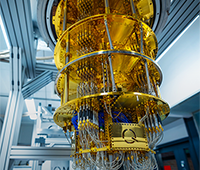 Okay, surely by now everyone has heard the term. It seems like every new smart phone commercial is blaring about the magic of near field communications, more frequently referred to as NFC. I think we can start off by agreeing that it is not magic, at least the technology, I don’t know about the hype. Is NFC something we should embrace or eschew? To make a decision like that, it helps to know just what it is.
Okay, surely by now everyone has heard the term. It seems like every new smart phone commercial is blaring about the magic of near field communications, more frequently referred to as NFC. I think we can start off by agreeing that it is not magic, at least the technology, I don’t know about the hype. Is NFC something we should embrace or eschew? To make a decision like that, it helps to know just what it is.
In this case, depending on who you talk to, NFC is either a subset or an extension of radio frequency identification (RFID), which has been around for years. The biggest differentiators between the two is that there are strict standards for NFC that define the frequencies (13.56 MHz for the curious, along with two sidebands) and the protocols devices use to communicate. The term “near field” is used primarily to indicate that NFC devices are designed for very short range communication, say four centimeters or less.
This is intended to provide one of several security layers. The short range of the device is due to its antennas being wire coils, thus, essentially electromagnets. When you bring the coils in two devices close enough, you basically are creating a transformer, which is used to both transfer data and power the tag. The developers promote the device as being intrinsically secure due to this, as they believed you would notice anybody waving a reader that close to your device. I’m not so sure this is a wise assumption, as they may have designed their devices to require this distance, that doesn’t mean that someone with the appropriate technology couldn’t read them from a greater distance, though isolating signals from multiple devices might be a challenge. While this might bring to mind echos of the NSA, I suspect the real threat is credit card and data theft.
Although it might be hard to believe from all of the hype, Philips Semiconductor and Sony coined the term in 2002 as an identifier for specifications they were developing for applying RFID to mobile phone applications.1 When Nokia partnered with them in 2004, they formally founded the NFC Forum, with the objective of further developing these specifications.
In addition to the specifications, the NFC Forum has created what they call the N-Mark.2 This symbol can be used for various purposes. One obvious one is to indicate that a device, poster, advertisement, product packaging, and even direct mail materials are NFC-enabled. More importantly, the N-Mark is supposed to be used to identify the touch point for aligning other NFC-enabled devices.
Near field communication can operate in any of three modes. These modes are referred to as:
- Reader/writer: An NFC device can read information from and write information to a smart tag.
- Peer-to-peer: Two NFC devices can bi-directionally exchange information with each other.
- Card emulation: An NFC device emulates a smart tag and appears as such to another reader.
It sometimes seems as if you really have to hunt to find a smart phone that doesn’t incorporate NFC these days. Well, with the exception of Apple who only started incorporating it into the iPhone 6, and even then restricted it to only work with their own payment system. There are indeed many potential benefits to NFC, for both users and businesses. Some of these applications are highly inventive, others are just the same old, same old, just in another medium. A random selection of these potential applications includes:
- cashless payment systems
- can be used to easily create a Bluetooth link between two NFC devices
- can be incorporated into social media, such as placing geolocation tags at various locations to allow simplified ‘check-in’
- allows transfer of files between devices, such as photos and MP3s
- can be used to create ‘smart’ objects
- Tags can be embedded in posters to supply event information.
- Tags can be embedded in gravestones and other monuments to provide a history of the person or monument, such as the RosettaStone Microchip.3
- can be used to control access to locations and devices
- BMW has NFC-enabled car keys.4
- control access to encrypted hard drives or other data
- Computer game designers are incorporating NFC chips into figurines that provide another way to interact with the game and possibly add extra features to your characters.5
If you don’t know whether your phone is NFC-capable, check out the definitive list at NFC World+.6 It is also possible to add NFC communication capabilities to some phones, as long as the version of Android you are running supports it. This can be done by adding either a SIM card or a microSD card containing an NFC chip. So, now that you have your fancy new NFC-enabled smart phone or tablet, you’re anxious to put it to the test and try it out, but what can you do with it? The answer depends on your interests. If you have buddies with compatible phones, you can exchange music and pictures, until you get bored of that. You can go around and read some of the RFID codes off of library books or store merchandise, other than that, the answer might be ‘not much,’ A lot of it depends on where you are in the world and the particular phone you have. Currently, NFC is much more popular in Europe and Asia, only now starting to take off in the US.
To some extent, this is another chicken or the egg story. People won’t go to the expense of embedding NFC tags in items until there are enough NFC-capable devices to make it worthwhile. On the other hand, there is no motivation for people to purchase NFC-enabled devices if there is nothing to read with them. However, to some extent, the story is darker than that.
Do you recall the strict ‘standards’ I mentioned earlier? We might as well start at the base and build up, so let’s start with a look at the standard for contactless smartcards, ISO/IEC 14443. This standard describes how these smartcards work, including the radio frequency (RF) modulation options, and it’s quite a story.7 A harbinger of things to come was that two major players pushed radically different approaches for modulating the RF. With the, um, wisdom of Solomon, a compromise was reached. They would include both approaches, which is why there is now an ISO/IEC14443 Type-A and an ISO/IEC14443 Type-B standard. To further complicate things, NFC is also designed to be backwards compatible with the FeliCa card specification from Sony, JIS X 6319-4.

Allowing bi-directional communication between two NFC devices required the development of a new communications protocol. This, in turn, required the development of two new standards to define the protocol, ECMA-340 and ISO/IEC 18092. While old in computer evolution time and dense with information, the slide presentation NFC vs ISO14443 vs Felica8 does an excellent job of illustrating the complexity and standards hidden behind NFC.
So, here is where it gets, um…, messier. The NFC forum has defined four tag types.
- Type 1: read- and re-writeable ISO/IEC 14443A based tag with memory capacity of 96 bytes to 2 Kbytes
- Type 2: read- and re-writeable ISO/IEC 14443A based tag with memory capacity of 48 bytes to 2 KBytes
- Type 3: factory-defined to be either read- and re-writeable* or read only based on the Japanese Industrial Standard (JIS) X 6319-4 based tag; maximum memory capacity of 1 MByte
- Type 4: Factory defined to be either read- and re-writeable or read-only; fully compatible with the ISO/IEC 14443A & ISO/IEC 14443B standards with a memory capacity up to 32 KBytes
According to the standard, all NFC devices should be able to read and write to all four of these tag types. What you don’t see in this list is what is called a Mifare or Mifare Classic tag, as it does not conform to the NFC standards. However, you are likely to find that many devices will read the Mifare Classic tag. The reason for this is that Phillips, now NXP Semiconductors, developed the Mifare Classic tag and incorporated support for it into their NFC chips. However, when other semiconductor manufacturers, such as Broadcom Texas Instruments, and ST Microelectronics, came out with their NFC chips, they explicitly followed the standard, so could not read the Mifare Classic tags. This explains why some smart phone models can read them and some cannot. Shortly after this, the Mifare Ultralight tag was developed, which did conform to the standard, though I’m sure this didn’t make anyone who had invested in the Mifare Classic tags very happy. Some phones without the NXP chips can read the tag number imbedded in a Mifare Classic tag, but not the data it contains.
![Figure 2: Breakdown of NFC technology[12]](/sites/scientificcomputing.com/files/Fig1_NFC_Technology_Breakdown_ml.jpg) To further complicate things, as shown in Figure 2, there are also three different types of Signal Technologies used, well, sort of. If you are working with NFC-A, you may be dealing with 4 byte or 7 byte encoding. What is shown as NFC-F here, for the Sony FeliCa encoding, is frequently shown as NFC-C in other documents. The result of all of this is that a technology designed to make things easy for the consumer can make it very difficult for the programmer, with plenty of trip-wires. While the programmers are very creative in working around many of these issues, occasionally they run into one when they can’t.
To further complicate things, as shown in Figure 2, there are also three different types of Signal Technologies used, well, sort of. If you are working with NFC-A, you may be dealing with 4 byte or 7 byte encoding. What is shown as NFC-F here, for the Sony FeliCa encoding, is frequently shown as NFC-C in other documents. The result of all of this is that a technology designed to make things easy for the consumer can make it very difficult for the programmer, with plenty of trip-wires. While the programmers are very creative in working around many of these issues, occasionally they run into one when they can’t.
As an example of this, I recently came across a USB hard drive with internal encryption. Drive access was very flexible, in that you could log into it through your computer using the app launched when you plugged it in; you could also unlock it by tapping it with a supplied NFC card; or you could unlock it using an NFC-enabled smart phone. However, the Signal Technology used had to be either NFC-A (4 byte) or NFC-F/C. Unfortunately, I’m told most smart phones in the U.S typically use NFC-B, so one of its most convenient features was worthless. While you might think this was a ridiculous thing to do, it happens all of the time. Most likely, it was designed in another country and the design engineers used what was familiar to them. It probably never crossed their minds that others would use an alternate configuration. This is a good lesson to keep in mind when designing experiments or working with multinational or multicultural teams! It is also a good lesson for when you do embrace the convenience of NFC. Don’t make assumptions that, because the literature says that a device or tag is NFC, it actually is — or that the two will work together. A careful reading of the actual device specifications will help, but even that is not as effective as actually testing the components together.
Even Free/Libre Open Source Software (FLOSS) developers are exploring it, with the Open NFC Project.9 I think it is safe to say that, unlike some touted technological innovations, NFC is coming. The biggest questions are
- How long will it take for the saturation of NFC devices to be sufficient to lure in commercial operations?
- How real is its security?
- how many ‘killer apps’ will be developed to take advantage of it
- whether manufacturers will work to improve the standard, or whether they’ll try to introduce their non-standard proprietary extensions (again)
Now, no matter how well it does catch on, I don’t know If I’d recommend going as far as Robert Nelson did, by actually implanting an NFC chip in his body,10 no matter how convenient it might be. Though, if you are into Biohacking, you can get the full kit for $99 or less.11 Companies can’t actually make you do that as a job requirement, can they…?
*Note: Some of the documents I’ve read state that if Type 2 and Type 3 tags are configured to be writable, you can only write to them once, other documents suggest that you can overwrite the data in them many times.
References
- H. Reisgies, Need to catch up fast: What is Near Field Communication (NFC)?, Sequent. (2015). http://www.sequent.com/what-is-near-field-communication-nfc/ (accessed September 10, 2015).
- NFC Forum, Identifying NFC, NFC Forum. (2015). http://nfc-forum.org/what-is-nfc/identifying-nfc/ (accessed September 10, 2015).
- Objecs LLC., RosettaStone Microchip | The Leader in Monument Technology, RosettaStoneMicrochip. (2015). http://www.rosettastonemicrochip.com/ (accessed September 10, 2015).
- M. Pinola, What Is NFC and How Can I Use It?, Lifehacker. (2012). http://lifehacker.com/5943006/what-is-nfc-and-how-can-i-use-it (accessed September 10, 2015).
- M. Egan, How to use NFC on your smartphone to do useful things, PC Advis. (2015). http://www.pcadvisor.co.uk/how-to/mobile-phone/what-is-nfc-how-nfc-works-what-it-does-3472879/ (accessed September 10, 2015).
- NFC World+, List of NFC phones, NFC World. (2015). http://www.nfcworld.com/nfc-phones-list/ (accessed September 10, 2015).
- NFC Admi, ISO 14443, ISO 18092, Type-A, Type-B, Type-F, Felica, Calypso NFCIP, NFC … – HELP!, Field Commun. Mob. Technol. (2015). http://www.nfc.cc/2009/01/03/iso-14443-iso-18092-type-a-type-b-type-f-felica-calypso-nfcip-nfc-help/ (accessed September 3, 2015).
- B. Jiang, NFC vs ISO14443 vs Felica, (2006). http://www.nfc.cc/wp-content/uploads/2009/01/Philips-NFC-vs-ISO14443-vs-Felica-SLIDES.pdf (accessed September 10, 2015).
- Inside Secure, The Open NFC Project | The reference Open Source NFC software stack., Open NFC. (2015). http://open-nfc.org/wp/ (accessed September 11, 2015).
- R.J. Nelson, Here’s why I implanted an NFC chip in my hand, Connectedly. (2014). http://www.connectedly.com/why-i-implanted-nfc-chip-hand (accessed September 11, 2015).
- A. Graafstra, Dangerous Things, Danger. Things. (2015). https://dangerousthings.com/ (accessed September 11, 2015).
- yamdankee, Automate Your Life With Your NFC Capable Smartphone – Part I, CR4. (2012). http://cr4.globalspec.com/blogentry/19906/Automate-Your-Life-With-Your-NFC-Capable-Smartphone-Part-I (accessed September 12, 2015).
John Joyce is a laboratory informatics specialist based in Richmond, VA. He may be reached at [email protected].



